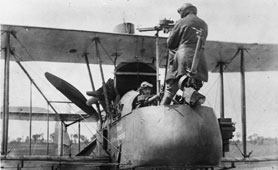When most people think of the Royal Flying Corps, Royal Naval Air Service and Royal Air Force in the First World War, it is invariably of aeroplanes and pilots. Whilst it was possible for a pilot to just jump in a plane and fly off, unless he was very quick and agile when starting his plane, it usually took at least one other person to swing the propeller to start the engine.
Since the advent of military aviation, all units operating not only aircraft and boats but also radar stations and a myriad of other tasks associated with aviation have always had a complement of officers and other ranks (airmen).
The records of RAF officers are in the series AIR 76 and these are easy to identify and consult as they are not only in name order, they are also online. So straight away, researching an RAF officer is made easy by virtue of digitisation of their records which are name searchable.
The records of service of RAF airmen are in the series AIR 79 and are arranged by service number. Each piece of AIR 79 covers a given range of service numbers. Prior to the completion of the name indexing project, it was necessary to know what an individual’s RAF service number was or to consult a very poor quality microfilm index in order to obtain it, in order to identify and order the correct piece of AIR 79.
By systematically going through all 2,807 pieces of AIR 79, the indexing project has extracted the names and service numbers of all the men whose records are in the series and put them into the catalogue. Of the 329,000 RAF service numbers within the series, some 8,500 are not available as the individual was either commissioned, in which case the record will almost certainly not survive (you will need to look at AIR 76), or because the record is still retained by the Ministry of Defence.
The personnel whose records can be found in AIR 79 arrived there via a number of different routes; they could have entered the RFC directly on creation or at any time up to 31 March 1918 and then moved by default into the RAF; they could have transferred into the RFC from a different part of the Army; they could have been in the RNAS prior to 1 April 1918 and joined the RAF by default when the RFC and RNAS were joined to create the RAF or they could have joined the RAF directly after 1 April 1918.
It is possible to find some RFC records in WO 363 and WO 364. If a man served in the RNAS and then the RAF you will find a record but with most of the details from 1 April 1918 onwards. The earlier record of an RNAS rating will be found in ADM 188.
So it is now possible to search AIR 79 by name and/or RAF service number and find the records of the fitters, riggers, drivers, batmen etc and even a vulcanizer!
Is there a reason why some records are “not available”?.
Paragraph 5 of the blog explains in basic terms why some records are “not available”. Some of the 8500 records which be made available at The National Archives in the future, when due to the length of service of subject individual, they will be elligble for transfer.
Although service numbers are very important to the subject individual (anyone who has served in the armed forces will understand this), some of the RAF numbers found in the records in AIR 79 are a little more significant or have a certain meaning.
RAF numbers 1-1360 were given to men who all enlisted into the RFC before the outbreak of the First World War.
RAF numbers 200001-255000 are all ex Royal Naval Air Service ratings who had Royal Navy Official Numbers between F1 and F 55000. Their earlier records are in ADM 188.
RAF numbers between 313000 and 315000 are ex Royal Navy ratings who served in the RN first, then specifically in the RNAS and then transferred into the RAF.